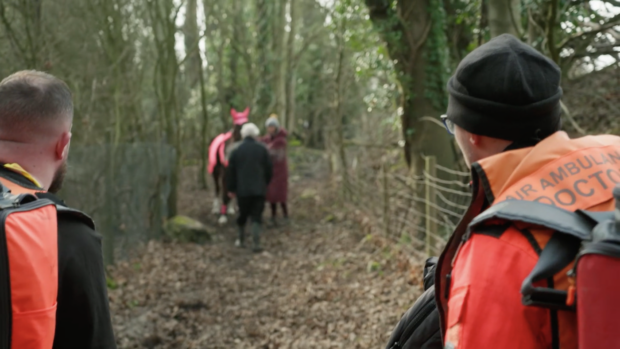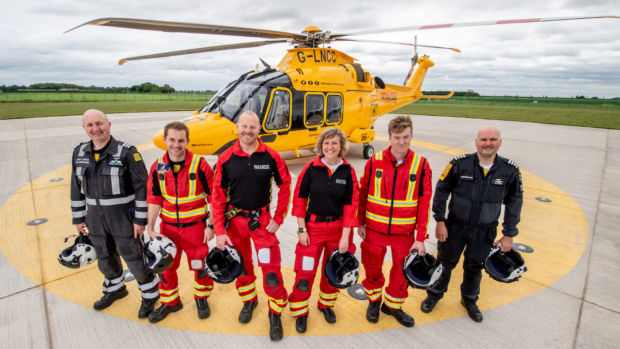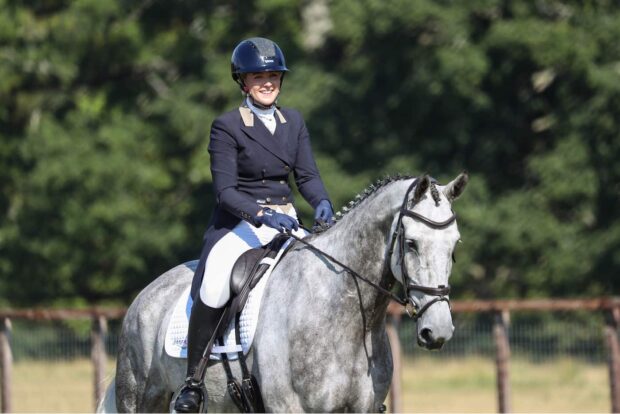Many horse riders receive vital urgent care from their local air ambulance every year after suffering a serious injury that has occurred in a remote location while riding or caring for their horses. But if you were faced with an incoming air ambulance, would you know what to do?
To mark Air Ambulance Week (9–15 September 2024), which calls on people all over the UK to help support their local air ambulance charity, Great Western Air Ambulance Charity advanced clinical practitioner in critical care, Vicki Brown, and pilot, Richard MacLaughlin, share their expert advice on what to do when an air ambulance is going to land in a location with horses nearby.
By following these simple tips you can keep yourself and your horses safe, as well as giving confidence to the crew that they can get to the patient as quickly as possible and attend to their immediate care.
1. When you call the emergency services, give the 999 call handler as accurate a location as possible. Use What3Words if you have GPS.
2. While waiting for the air ambulance to arrive, stay with the injured person if it is safe to do so and keep them warm if they’re still on the ground. Use whatever you have to hand, such as clothing, horse rugs and tarpaulins.
3. When the air ambulance comes in to land, the pilot and crew will look for a landing site as near to the patient as possible that has no obstacles or hazards. A big field with no horses or livestock either in it or adjacent to it is ideal.
4. Horses spook easily and can be unpredictable. If horses and animals can be moved inside, please do so.
5. Please don’t stand in a field where you want the air ambulance to land, because it won’t be able to – the pilot will need to find another suitable landing site. If you cannot vacate the field, please move to the edges.
6. Outdoor arenas are not always suitable to land in as they can be full of loose objects such as jumps, poles and sometimes the patient. The helicopter creates a strong downwash and the arena’s surface can blow up, as well as sending loose objects flying.
7. No horses should be ridden in the vicinity. Please dismount and hold your horse if you are unable to vacate the area.
8. If a rider comes across an incident unrelated to them or their yard (for example, a road traffic collision), hand the situation over to someone else if possible so you can leave the scene with your horse. If no one else is around to help, hi viz will help keep you safe and make it easier for the air ambulance and emergency services to locate you. In this situation, please tell the emergency services that there are horses nearby.
9. When the air ambulance lands, it will need time to shut down. Please don’t approach the helicopter until the blades have stopped turning and the pilot has left the aircraft. It is better to wait for the crew to come to you.
10. When you see the helicopter preparing for take-off, please follow the same tips as for landing. When the patient is boarded onto the helicopter, a smooth and fast departure is essential to ensure the patient is taken to hospital as quickly as possible.
- To stay up to date with all the breaking news throughout the National Dressage Championships, Blenheim Horse Trials, Horse of the Year Show and more, subscribe to the Horse & Hound website
You may also be interested in…

Trauma doctor shares simple life-saving actions all equestrians should know
Dr Diane Fisher spoke about the simple, potentially life-saving actions, people can take if a friend hits their head at

Calls for riders to download ‘life-saving’ location app
‘You never know when an emergency might happen, but with what3words, you’ll always be able to say exactly where help

Saving lives: rider thanks crucial air ambulance after rotational fall

Subscribe to Horse & Hound magazine today – and enjoy unlimited website access all year round




